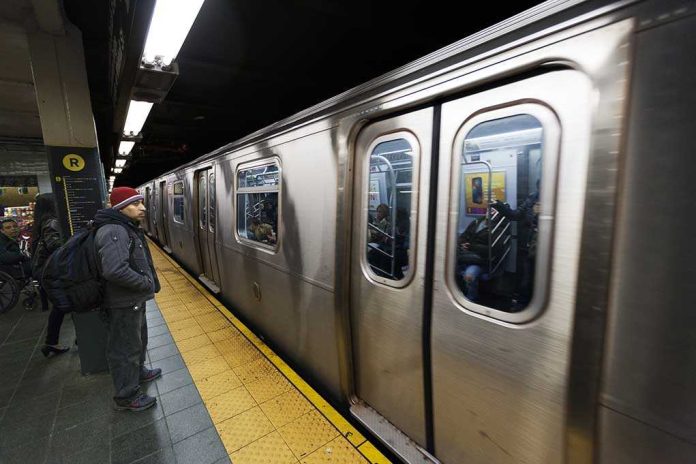
Eleven people boarded a routine train and stepped off as survivors of a nightmare, raising the urgent question: how safe is public transport when violence erupts in the most confined of spaces?
Story Snapshot
- Stabbing rampage on a London-bound train left 11 hospitalized, shocking a nation accustomed to railway safety.
- Police quickly arrested two men, later releasing one, and confirmed no terrorism link, focusing attention on motive and response.
- Train staff and passengers played pivotal roles in limiting casualties, diverting the train for emergency intervention.
- The incident has triggered renewed scrutiny on knife crime and emergency protocols in the UK rail system.
Violence Strikes in Transit: Anatomy of a Confined Crisis
Saturday, November 1, 2025. A high-speed train slices through the English countryside, Doncaster to London, its passengers lulled by routine. But after the Peterborough stop, normalcy vanishes. A man boards, pulls a blade, and in moments, eleven people are wounded—one critically. In this metal tube moving at over a hundred miles an hour, there’s nowhere to run. The crew and bystanders, acting with astonishing clarity, signal the driver. The train is diverted to Huntingdon station, transforming the carriages from a crime scene to an emergency triage site. Police arrest two British men on the spot, one later released, and a 32-year-old remains in custody on suspicion of attempted murder. Authorities state with certainty: not terrorism, but raw, inexplicable violence.
As forensic teams comb the train and station, the tally of the injured and the trauma of the witnesses come into focus. The rarity of such an event on UK railways is not lost on investigators or the public. The UK’s rail system—renowned for safety—has seen isolated incidents before, but nothing on this scale. The last time this level of violence hit public transport, terrorism was the suspected driver. This time, police are unequivocal: there is no evidence to support a terrorism link. The motive remains a mystery, and authorities urge the public not to speculate. The wounded, including a railway employee who tried to intervene, are rushed to hospitals. The immediate aftermath is a blur of medical helicopters, cordoned-off platforms, and passengers sitting in shock, some covered in blood, others in blankets, all united by disbelief.
The Rapid Response: Staff, Passengers, and Police Under Pressure
The true measure of crisis response reveals itself in chaos. The train staff, who swiftly communicated with the driver to divert at the nearest accessible station, are credited with saving lives. Passengers, some of them strangers moments before, banded together to defend, to help the wounded, and to detain the suspect until police arrived. In the tight confines of a train car, every second counts. Emergency services—paramedics, police, and firefighters—descended on Huntingdon station with practiced precision. The initial arrests underscore the confusion of such scenes: two men are detained, one quickly exonerated. Police move fast to secure the train, prevent further injury, and begin the painstaking process of piecing together what happened, who was involved, and why.
The investigation continues past the weekend, with detectives poring over security footage, interviewing traumatized passengers, and working to build a timeline. The singular focus: determine motive, ensure public safety, and provide answers to a rattled population. Police and government officials speak to the press, reiterating the facts, emphasizing the absence of a terrorism connection, and commending the bravery of the train staff. In the days that follow, the station and rail line return to service, but the questions linger. How did this happen? Could it have been prevented? And what does it mean for the future of train travel in the UK?
Ripple Effects: Public Fear, Policy Debates, and the Search for Answers
The consequences of the attack ripple far beyond the victims and the scene. Short-term, the rail operator faces disrupted service and shaken commuters. The trauma for the victims and witnesses will not soon fade. In the longer view, the incident renews debate about knife crime in Britain and the security of public spaces. Public officials confront the delicate task of balancing transparency with restraint, determined not to inflame public fear unnecessarily. Security experts, criminologists, and policymakers weigh in, noting the rarity of such mass stabbings on trains, the effectiveness of the emergency response, and the challenges inherent in preventing violence in open, mobile environments.
The attack compels a fresh look at emergency protocols and staff training for UK trains. Calls for policy reviews on knife crime are renewed, but experts caution against knee-jerk reactions. The broader industry watches closely, bracing for potential regulatory changes. Meanwhile, the social fabric—woven from the confidence of everyday safety—is tested. Communities around Huntingdon, passengers who travel the route daily, and staff who keep the trains moving all grapple with a new, unsettling reality: even in the safest spaces, vigilance is never optional. The investigation’s findings and the justice process for the accused will shape not only the legacy of this attack, but also public trust in the systems meant to protect them.









